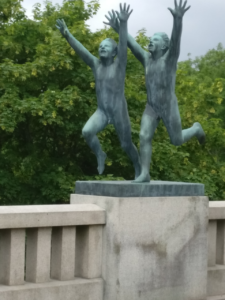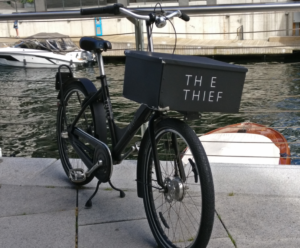 Text and photos by Mary L. Peachin
Text and photos by Mary L. PeachinVol. 21, No. 8, April, 2018
Oslo, one of Europe’s fastest-growing cities, is Norway’s metropolitan capital. Wedged between forests and fjords, new eye-catching architecture neighborhoods of the country’s largest city (population, 700,000) has transformed itself into a cosmopolitan hub. Norway, formerly a part of Sweden, is now a democratic, constitutional monarchy. A compact city, hosting an abundance of museums, restaurants, and art, is easy to explore on foot or by bike or efficient public transportation. Accessible, it maintains a relaxed smaller town atmosphere.

Since 1814, Oslo has been the center of the Norwegian government and home to the Royal Family. The country’s largest cultural institution include the Norwegian Opera & Ballet, National Theatre and National Museum of Art, Architecture and Design. Oslo offers, first-rate art exhibitions and opera, ballet and theatre performances.
Baitservice Ferry provides passenger service to the Viking Ship Museum on nearby Bygdoy Peninsula. Ornately carved vessels, dating back centuries, are exhibited along with a video simulation of Norse travails videoed on a front domed wall including both sides. One ornate ship, found on a farm with an estimated construction time of 21 years, was said to be a 1,000 years ago.
The easiest way to see the walkable city, especially on a rainy day, is to take the Hop On-Hop-Off bus. This city of museums and a castle also features good restaurants.
Louise Restaurant serves a variety of seafood towers, mussels and frites with homemade mayonnaise, and the ever popular moose hamburger.
Mathallen food court houses a series of vendors offering food, pastries, or meals. Vulkanfisk served delicious fish and chips made with haddock preceded by creamy fresh fish soup.
 On a hilltop overlooking Oslo Fiord, Ekebergrestauranten, a special occasion dining place, serves typical Norwegian food. Diners can stroll thru a sculpture park before or after dinner.
On a hilltop overlooking Oslo Fiord, Ekebergrestauranten, a special occasion dining place, serves typical Norwegian food. Diners can stroll thru a sculpture park before or after dinner.
“Did we steal you away from everyday life today?” That’s the concept for the name of the Thief Hotel. The property ranks as one of the “alpha geek” of techy hotels. Modern artwork has moving parts: a blinking woman moving hands, a trio of veiled women adjusting their head scarves, and more. Artists including Jeff Koons, Takashi Murakami, Damien Hirst, Cindy Sherman, and Richard Prince
Rooms have smart televisions, lights have motion detectors. Not so great for bathroom trips during the night. The breakfast offerings are all homemade including the mustard. Centered between iconic Astrup Fearnley Museum, Tjuvholmen and Oslofjord canals, most of its 116 rooms have balconies with waterfront views.
Oslo’s Grand Hotel is considered one of Norway’s more well known, prestigious accommodations. Since opening in 1874, it has welcomed international guests, world leaders, celebrities and Nobel Peace Prize laureates in its 274 rooms. Author Henrik Ibsen was a regular. Accommodations also include 54 suites, a fine dining restaurant, a rooftop terrace bar, Artesia Spa and a fitness facility.

Oslo is a picturesque city surrounded by water. The locals are friendly, the food is good, and while it may not enjoy the city of Bergen’s popularity, it’s well worth a visit if you’re traveling in Scandinavia.
